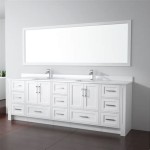Designs For Bathroom Sinks: A Comprehensive Guide
The bathroom sink, often underestimated, serves as a focal point within the bathroom, contributing significantly to both functionality and aesthetic appeal. Selecting the right sink involves considering various factors, including space constraints, plumbing configurations, personal style preferences, and budgetary limitations. This article provides a comprehensive overview of the diverse designs available for bathroom sinks, examining their respective characteristics, advantages, and practical considerations.
Types of Bathroom Sinks: A Detailed Examination
Bathroom sinks are available in a wide array of designs, each possessing unique characteristics that cater to specific needs and aesthetic visions. Understanding the different types of sinks is crucial for informed decision-making. The following sections delve into the most common sink types, highlighting their distinguishing features.
1. Undermount Sinks: Undermount sinks are installed beneath the countertop, creating a seamless and clean aesthetic. The rim of the sink is attached to the underside of the countertop, allowing for easy cleaning as debris can be wiped directly into the sink without obstruction. This design is particularly well-suited for countertops made of solid materials like granite, quartz, or marble, showcasing the material's beauty. Undermount sinks maximize countertop space and contribute to a minimalist bathroom design. However, this style typically requires professional installation and is generally more expensive than drop-in sinks.
2. Vessel Sinks: Vessel sinks, also known as above-counter sinks, are installed on top of the countertop, resembling a freestanding bowl. This design adds a dramatic and contemporary flair to the bathroom. Vessel sinks are available in numerous shapes, sizes, and materials, including glass, ceramic, stone, and metal, providing ample design flexibility. Installation can be relatively straightforward, though careful attention must be paid to the height of the countertop and faucet to ensure comfortable use. A potential drawback is that vessel sinks can take up more countertop space and may be more prone to splashing.
3. Drop-In (Self-Rimming) Sinks: Drop-in sinks, also known as self-rimming sinks, are installed into a pre-cut hole in the countertop. The rim of the sink rests on the countertop surface, creating a visible edge. This is a common and relatively inexpensive option, making it popular for both new construction and bathroom renovations. Drop-in sinks are available in a variety of shapes, sizes, and materials. They are generally easy to install, although proper sealing around the rim is essential to prevent water damage. The visible rim can be considered less aesthetically appealing than undermount sinks, although this is largely dependent on individual preferences.
4. Pedestal Sinks: Pedestal sinks consist of a sink basin supported by a freestanding pedestal base. They are a space-saving solution, particularly suitable for smaller bathrooms or powder rooms. Pedestal sinks offer a classic and elegant aesthetic. However, they typically lack built-in storage, which may necessitate the addition of separate storage solutions. Plumbing is exposed with a pedestal sink, so ensuring a clean and organized plumbing setup is crucial. The pedestal effectively conceals the pipes but offers no storage capacity.
5. Wall-Mounted Sinks: Wall-mounted sinks are directly attached to the wall, eliminating the need for a countertop or pedestal. This design creates a sense of openness and is ideal for small bathrooms or for achieving a modern and minimalist look. Wall-mounted sinks allow for adjustable height, which can be advantageous for users with specific needs. Similar to pedestal sinks, wall-mounted sinks offer limited storage, and plumbing is often exposed. Wall reinforcement is critical to ensure the sink is securely mounted and can support the intended weight.
6. Console Sinks: Console sinks combine the aesthetics of a pedestal sink with the functionality of a countertop. They feature a sink basin supported by legs, often made of metal or wood, along with a countertop surface. Console sinks provide a balance between space-saving design and storage options. They are available in various styles, from traditional to contemporary, offering versatility in design. However, console sinks can be more expensive than pedestal sinks, and plumbing may still be partially exposed.
7. Integrated Sinks: Integrated sinks are seamlessly molded into the countertop, creating a smooth and continuous surface. This design is typically found in modern and contemporary bathrooms. Integrated sinks are easy to clean and maintain, as there are no seams or crevices to trap dirt or grime. They are available in a range of materials, including solid surface, acrylic, and engineered stone. While integrated sinks offer a sleek aesthetic, they may be more difficult and costly to repair if damage occurs to either the sink or the countertop.
Materials Used in Bathroom Sink Construction
The material of a bathroom sink significantly impacts its durability, aesthetic appeal, and maintenance requirements. Selecting the appropriate material is vital to ensure the sink meets both functional and aesthetic expectations. The following sections explore the common materials used in bathroom sink construction.
1. Ceramic (Porcelain and Vitreous China): Ceramic, particularly porcelain and vitreous china, is the most prevalent material used in bathroom sinks. These materials are durable, non-porous, and resistant to stains and scratches. Ceramic sinks are also relatively easy to clean and maintain. Vitreous china offers a higher level of resistance to staining and bacteria compared to standard porcelain. Ceramic sinks are available in a wide range of colors and styles, making them a versatile choice for various bathroom designs. However, ceramic sinks can be susceptible to chipping or cracking if subjected to heavy impact.
2. Stone (Granite, Marble, Travertine): Stone sinks, crafted from materials like granite, marble, or travertine, offer a luxurious and natural aesthetic. Each stone sink is unique, displaying variations in color and veining. Stone sinks are exceptionally durable and can withstand daily use. However, they are porous and require regular sealing to prevent staining and water damage. Marble, in particular, is susceptible to etching from acidic substances. Stone sinks are typically more expensive than ceramic sinks and require specialized cleaning products.
3. Glass: Glass sinks add a modern and artistic touch to the bathroom. They are available in various colors, shapes, and textures, ranging from clear glass to frosted or patterned designs. Glass sinks are non-porous and easy to clean. However, they are more fragile than ceramic or stone sinks and may be prone to scratches or chips. Tempered glass is recommended for bathroom sinks to enhance durability. Water spots and fingerprints can be more visible on glass sinks, requiring more frequent cleaning.
4. Metal (Stainless Steel, Copper): Metal sinks, typically made of stainless steel or copper, offer a sleek and contemporary aesthetic. Stainless steel sinks are durable, resistant to rust and corrosion, and easy to clean. Copper sinks possess antimicrobial properties and develop a unique patina over time. Metal sinks can be susceptible to dents and scratches. Copper sinks can be significantly more expensive than stainless steel sinks. The metallic finish can complement modern bathroom fixtures.
5. Solid Surface (Acrylic, Resin): Solid surface sinks, made from materials like acrylic or resin, offer a seamless and non-porous surface. They are resistant to stains, scratches, and impact. Solid surface sinks are available in a variety of colors and patterns, often mimicking the look of natural stone. They are easy to clean and maintain, and any scratches can typically be buffed out. Solid surface sinks are a versatile and durable option, often found in integrated sink and countertop combinations.
Factors to Consider When Choosing a Bathroom Sink
Selecting the appropriate bathroom sink involves careful consideration of several key factors to ensure the chosen sink aligns with the user's needs, preferences, and the overall bathroom design. These factors include space constraints, design style, functionality, and budget.
1. Space and Layout: The size and layout of the bathroom are primary considerations. Smaller bathrooms may benefit from space-saving options like pedestal sinks or wall-mounted sinks. Larger bathrooms can accommodate larger sink designs, such as double-bowl sinks or console sinks. The placement of the sink should be carefully planned to ensure comfortable access and adequate clearance around the sink area. Consider the swing of the bathroom door and the location of other fixtures, such as the toilet and shower.
2. Style and Aesthetics: The sink should complement the overall style and aesthetic of the bathroom. A traditional bathroom may feature a pedestal sink or a drop-in sink with a classic design. A modern bathroom may incorporate a vessel sink or a wall-mounted sink with clean lines. Consider the color, shape, and material of the sink to ensure it harmonizes with the other elements of the bathroom, such as the countertop, cabinetry, and fixtures.
3. Functionality and Usage: The functionality of the sink should align with the user's needs and habits. For example, a family bathroom may require a sink with ample counter space for toiletries and grooming supplies. A powder room may only require a small and decorative sink. Consider the depth and width of the sink basin to ensure it is adequate for the intended usage. The height of the sink should also be considered to ensure comfortable use for all users.
4. Budget: Bathroom sinks are available at a wide range of price points, depending on the material, design, and brand. Establish a budget before beginning the selection process to narrow down the options. Factor in the cost of installation, which can vary depending on the type of sink and the complexity of the plumbing. Consider long-term costs, such as maintenance and repairs, when evaluating different sink options. While a lower upfront cost may be appealing, a more durable and higher-quality sink may prove more cost-effective in the long run.
5. Plumbing Considerations: The existing plumbing configuration will influence the choice of bathroom sink. The location of the water supply lines and drainpipe will determine the type of sink that can be installed. For example, replacing a pedestal sink with a wall-mounted sink may require relocating the plumbing connections. Consult with a qualified plumber to assess the plumbing situation and ensure that the chosen sink is compatible with the existing infrastructure.

Bathroom Sink Styles

16 Amazing Ideas For Countertop Bathroom Basins Basin

Designer Bathroom Sinks Wash Basins Livinghouse

8 Trending Bathroom Sink Styles You Need To Know

The Right Vessel Sink Can Create Perfect Contemporary Bathroom Beautiful Homes

51 Bathroom Sinks That Are Overflowing With Stylistic Charm

21 Best Bathroom Vanity Ideas 2024 See Our Top Picks

Modern Bathroom Vanity Design Regalo Kitchens

14 Splendid Small Bathroom Sink Ideas Shelfgenie

15 Small Bathroom Vanity Ideas That Rock Style And Storage







